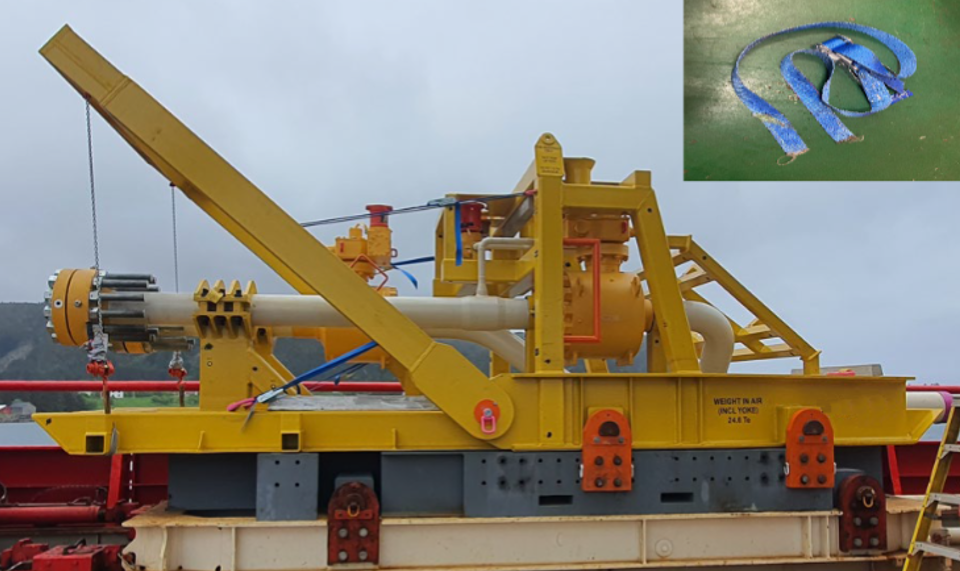Pipeline End Manifold yoke dropped from 45° position
What happened
During adjustment of the yoke securing arrangement for a PLEM (Pipe Line End Manifold), the cargo strap failed resulting in the yoke falling and landing in its horizontal resting position. Two persons were working inside the PLEM in close proximity to the yoke at the time. Neither were injured.
While the rigging team on the vessel were re-arranging the rigging securing the PLEM yoke at a 45° position, the port side top cargo strap tension was released. This resulted in sudden movement of the yoke, causing the starboard cargo strap to fail and the yoke to drop to its horizontal position. Note: re-arrangement of the rigging was initiated after a safety observation on weak rigging was raised by deck crew.

What went wrong
- The wrong kind of cargo strap was used;
- Old 4 tonne straps were used instead of the new 5 tonne straps provided;
- Specific rigging described in the task plan was not used.
- The cargo strap was used in an incorrect way;
- The team copied the use of cargo straps from how it had been done on previous projects;
- The yoke was not recognised as a suspended load;
- There was a lack of understanding of the correct use of cargo straps, which were not to be used for lifting or holding the load.
- There was inadequate risk assessment of change.
- The port side holdback was released without considering if the single holdback was sufficient;
- There was no MoC (Management of Change) process undertaken, so planning did not break the task into steps and was not properly risk assessed;
- “Task seen as routine” – the task was considered standard deck work.
Actions and learning
- Design teams to:
- review standard designs to incorporate engineered securing of yokes & wings;
- review checklist for standard designs.
- Take caution when handling or working near temporarily restrained yokes and wings and consider additional controls to prevent or mitigate unexpected movement;
- Review boundaries between changes that require formal “Management of Change” and those that are more general;
- Review TRA’s (Task Risk Assessments) to ensure a better understanding of task limitations;
- Use the rigging and equipment provided for the specific project task in hand;
- Review the practice of securing suspended loads using cargo straps.
Members may wish to refer to:
Safety Event
Published: 27 February 2024
Download: IMCA SF 05/24
IMCA Safety Flashes
Submit a Report
IMCA Safety Flashes summarise key safety matters and incidents, allowing lessons to be more easily learnt for the benefit of all. The effectiveness of the IMCA Safety Flash system depends on Members sharing information and so avoiding repeat incidents. Please consider adding [email protected] to your internal distribution list for safety alerts or manually submitting information on incidents you consider may be relevant. All information is anonymised or sanitised, as appropriate.
IMCA’s store terms and conditions (https://www.imca-int.com/legal-notices/terms/) apply to all downloads from IMCA’s website, including this document.
IMCA makes every effort to ensure the accuracy and reliability of the data contained in the documents it publishes, but IMCA shall not be liable for any guidance and/or recommendation and/or statement herein contained. The information contained in this document does not fulfil or replace any individual’s or Member's legal, regulatory or other duties or obligations in respect of their operations. Individuals and Members remain solely responsible for the safe, lawful and proper conduct of their operations.
